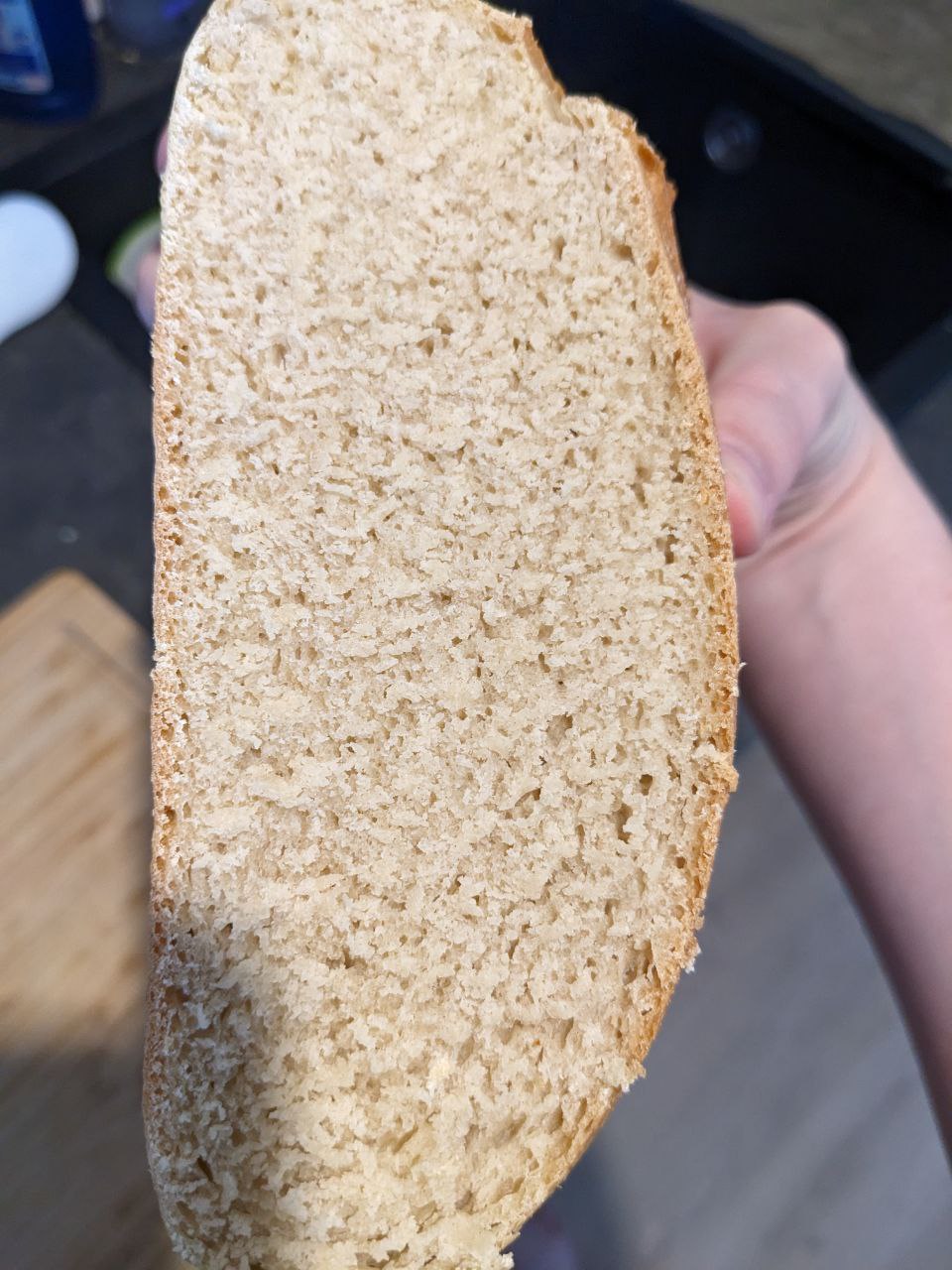June 1, 2023 - 3:35am

coarse crumb, but why?

Hello everyone,
I try my hands at bread baking for 2 months now and encounter always the same problem, coarse crumb (see picture)
For this bread I followed this recipe
I have used high gluten bread flour, used active dry yeast, did a stretch and fold (as far as possible) for kneading, used a high wall cast iron pan as baking surface, oven was properly steamed, but I have no clue why I don't get an crumb as he did


But not an issue in itself. While low hydration can result in a dense crumb it doesn't have to be the case nor might it be the only problem.
Two questions...
1: how hydrated does the dough feel? Is it very dry? Does it have good extensibility?
2: how much does the dough rise during the bulk ferment? The recipe gives a time but no visual description of when it looks ready.
I'd aim for a tacky dough. Not too dry but not too wet it is unmanageable. You should be able to stretch and fold the dough. If it has no stretch to it then it needs more water.
And only move onto shaping when the dough has doubled. Ignore the clock.
Thanks for the answer
The dough felt neither dry nor really tacky, it got smooth quite fast
The dough got quite stretchy at the end of the second fermentation
So the issue could be that it wasn't rising enough.
When I should go for the first fold? When the dough doubled in size?
I misread it the first time. I thought it said...
Knead... let rise... shape and bake.
So there is a rest period and a fold. And you say it does feel right and has hoid extensibility. Sounds good!
So the question is how much has it risen by the time you come to shape it? And also, what flour are you using?
My inexperienced eye reckons that needs more water.
That looks all the world like cake texture. From that image my initial thought is the gluten has broken down.
I suspect it is your water (if it is not an issue with your flour batch). I have something similar when my water filter is getting close to needing changing.
The stretch and fold technique may have masked the issue. The collapse in structure usually gets worse the more you need...so the small amount of stretch and fold isn't revealing the gluten breakdown. It would leave the dough with just that initial basic mixed structure but no real gluten development - hence in these instances it comes out looking like cake.
We have really hard water here. Didn't knew it could be a problem
My flour has 12% protein, tried it also with 2 other brands and had the same issue
We have hard water too, one of the hardest areas in the UK but if you see my thread that's just below this one, you can see I have a much less cakey crumb than you. I don't filter it, that's straight out of the tap.
Good news that the flour is not the issue.
The useful thing about water is it is easy to test for - just one batch with bottled water.
Be aware, water issues aren't just limited to hardness. I first noticed it after a flood here and other have noted issues after an event in their catchment or a disturbance in their pipes. I mention it as most people overlook it as an issue.
For us, bread acts as a 'canary in the coal mine' for our water quality.
I've baked bread like that before!
To me it looks like a combination of two possible issues: under risen and under baked.The recipe is very basic and looks very solid. It's a small loaf but the only concern I have with the recipe is possible tose rise times; they look a bit short to me.
May I suggest that you, first, check that your yeast is "fresh". Then heed the warnings about dough and room temperature effects on the bulk fermentation (first rise). Focus on the look and feel of the dough rather than the timing in the recipe as that can only be a guide. Same with the final rise after shaping.
May I also suggest that you verify the temperature acuracy of your oven. Then bake to the recipe timing, and if the color is still pale then bake some more. The traditional test is to tap the bottom of the loaf to listen for a "hollow sound". You can also use a probe thermometer and verify that internal temperature is 195 to 210 degrees Farenhiet. There are many suggestions that 190 degrees is sufficient but I find that to often be gummy crumb so use this higher temperature guideline specified by America's Test Kitchen. And as they state, sometimes internal temperature is reached before the crust color has been achieved so additional baking time may be warranted.
https://www.americastestkitchen.com/cooksillustrated/how_tos/5719-testing-bread-for-doneness
@therearenotenoughnoodlesintheworld:
You have been correct, my water is far too hard.
Bought a bottle of water and I got fluffy bread with the same recipe. You are a life saver
I never came across of this problem. It should be mentioned in any FAQ
I think it is happening due to lack of water
Chlorine or chloramine are more likely to be the issue than hardness. But bottled water would solve either issue.